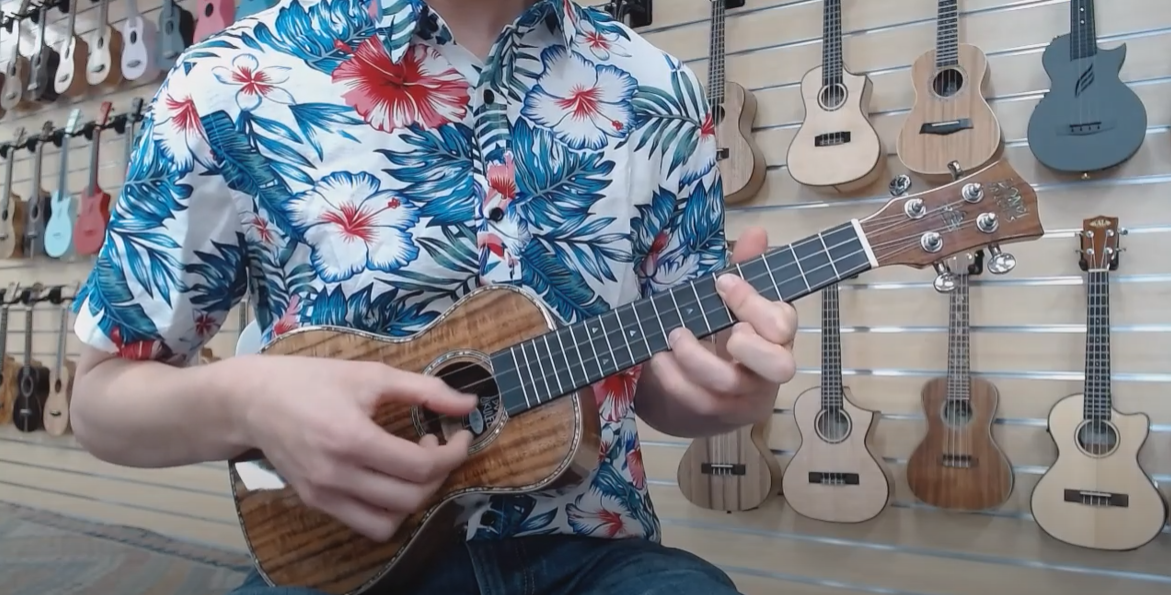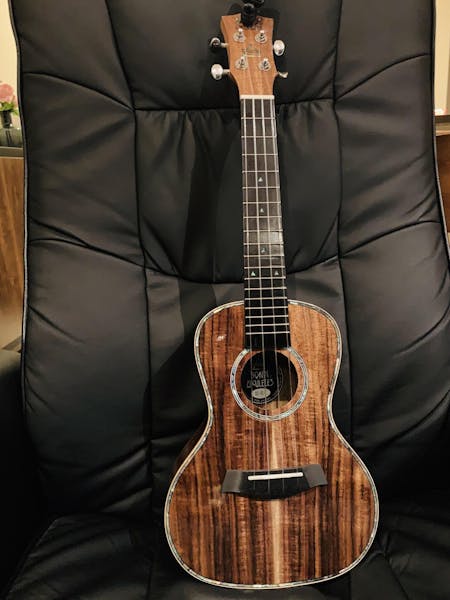Is Koa Wood Good For Ukuleles? 3 Reasons Why It is Special

For ukulele players and enthusiasts, there’s nothing quite like the beauty of a Koa ukulele.
This reddish-brown wood is said to impart an unmatched warmth to each string, something that even some of the greatest luthiers have difficulty replicating with more common woods like mahogany.
Let's uncover why Koa wood is so special for crafting ukuleles.
But first, did you know some interesting tidbits about this rare resource? Get ready to be wowed by the wonders of Koa!
LET'S BEGIN WITH THE TREE ITSELF, THE KOA
Koa wood is a Hawaiian treasure that's not just special for its beauty, rarity, and symbolic meaning but also for the stories it holds.
Different generations have long valued this priceless resource in Hawaiian culture. Featuring distinct grain patterns, its reddish-orange to golden yellow hues look as if they were brush strokes created by some of Hawaii's best artists.
Its reputation as a rare species comes from the fact that the tree only grows in the tropical paradise of Hawaii. Its habitat is typically found high up in the mountains, with elevations ranging from 2000 to 6000 feet above sea level—an optimal spot for finding unrivalled beauty!
MORE INTERESTING FACTS ABOUT THE KOA
Watching koa trees grow and seeing how their leaves change over time is fascinating. During this process of transformation, it's possible for two distinct forms of foliage to be found on a single branch!
The Koa tree is a truly remarkable species!
Why?
Not only does it boast lush foliage and pristine beauty, but its self-watering abilities are certainly something to marvel at; it is truly an incredible plant that deserves much admiration!
With its leaf shape and structure, it collects moisture from passing clouds to provide itself with the hydration needed for growth—talk about impressive!

If those facts about the Koa tree weren't impressive enough, here are a few more:
- It's been said that patience is a virtue, and Koa trees are certainly proof of that. Their tiny seeds have been known to remain dormant in the ground for up to two and a half decades before finally sprouting!
- Koa trees have a special ability that makes them self-sufficient - they can create their own nitrogen supply, rendering fertilization obsolete. Talk about superpowers!
- Koa forests are more than just a pretty face; they're also home to some of the world's rarest bird species. With over 30 native Hawaiian forest birds, including 17 that have endangered status, these trees provide vital sanctuary for our feathered friends!
- That Koa leaf? It'll be gone faster than a Hawaiian breeze - literally! In about 18 months, that litter will have composted and vanished like it was never there.
- Koa trees may appear tough, but strong winds can still send them packing. While they are wind resistant and often stand their ground, these durable trees have been known to snap off or get uprooted during exceptionally powerful gusts.
WHAT MAKES KOA WOOD SPECIAL?
The sweet sound of the Koa ukulele has been heralded by experts and amateurs alike; it's a must-have for any aspiring strummer who wants to take their tunes to the next level.
But what really makes it so special?
Here are three big reasons why every ukulele aficionado should consider investing in one of these amazing instruments!
-
KOA IS PART OF THE HAWAIIAN HERITAGE — Hawaiians have long held Koa in high regard, a sacred resource that played an integral part in their culture. To them, it was more than just wood—from gourds to warrior weapons, this precious material served many purposes and was deeply embedded into the Hawaiian heritage.
Way before modern inventions like iPhones and MacBooks, Koa wood was the "it" item of its time! During King Kamehameha's reign in the late 1700s in Hawaii, this treasured tree provided a wealth of resources, from canoes to swords! It even gave some warriors their name, as they were referred to as "Koa."
The power that lay within these mighty trees helped the Hawaiian monarchs achieve great feats. Later, it would be declared "kapu,” or prohibited, for anyone else but royalty, making sure its grandeur stayed uniquely with Hawaiians alone. -
THE UNIQUE WOOD GRAIN IS EXTRAORDINARY — Blessed with a kaleidoscope of colours and an undeniable sense of mysticism, Koa wood is truly one-of-a-kind. Its rolling hues range from golden blonde to red auburn to deep brown depending on the tree's age, the elevation it grows at, and its surrounding soil, so each board has something special about it! There are few materials that can match this majestic Hawaiian native for pure beauty.
Straight-grained Koa has a classic look that won't go out of style—you can find it everywhere, from the most exclusive furniture stores to budget-friendly DIY shops. But if you're after something more unique and eye-catching, don't worry! Nature knows how to surprise us with the figured or wavy patterns of wood grain—the possibilities are endless!
Now here’s what’s more interesting…
Curly or wavy grain patterns may be considered the holy grail of woodgrain. If you're lucky enough to find them in old-growth trees, consider yourself blessed; they command quite a hefty price tag!
Despite this rare beauty, "figuring" is also sought after, and these swirling details are usually created thanks to nature's own pressure cooker: when branches twist under wind stress or fork at an angle due to weight, it forces some incredible pattern changes into the tree’s formative years.
Koa wood is already a stunning natural material, but its beautiful curl-like grain and mesmerising holographic finish take it to the next level!
Chatoyancy, or the cat's eye effect, gives Koa lumber an extra dimension of beauty that can't be found in any other type of wood, making this unique gem stand out from all others—truly one of nature's greatest gifts!
-
KOA TREE IS A RARE COMMODITY — Trees like Koa are actually quite rare, with the cool elevations of 2,000–7,000 feet on the Hawaiian Islands as their home making them hard to come by. This has resulted in strict rules from authorities to ensure harvesting is kept at bay and only comes from dead or fallen tree sources since living ones must be protected!
The lush Hawaiian islands were once blanketed in magnificent Koa forests, but unfortunately, during the 1800s, much of the habitat of these majestic trees were sacrificed for agricultural needs.
Consequently, their populations have dramatically dwindled—though those lucky enough to witness a forest full of Koa know how truly remarkable it is! Thankfully, there are still some protected areas around today, allowing people of all ages to admire this magnificent species.
FINAL THOUGHTS
Koa wood—it's in a league of its own. There's no mistaking that rich, one-of-a-kind grain pattern and dazzling colours... not to mention the tones so special they belong in their own class! But what makes Koa most prized is more than just how beautiful it is; with generations of Hawaiian history held within each piece, this remarkable wood tells stories all on its own.
And when you get down to brass tacks? Well... Let's say there simply isn't anything else like it out there.
Ready to strum some tunes with a beautiful Koa ukulele? Check out our top picks and become the star of your next jam session! Click HERE to get started.
 Lifetime Warranty
Lifetime Warranty  60 Day Returns Policy
60 Day Returns Policy 1-2 Day Delivery
1-2 Day Delivery 































Leave a comment